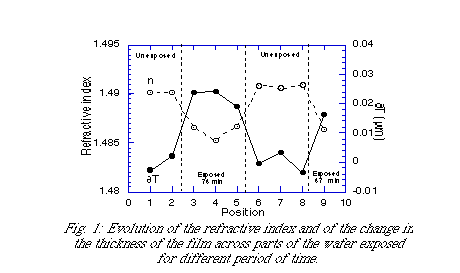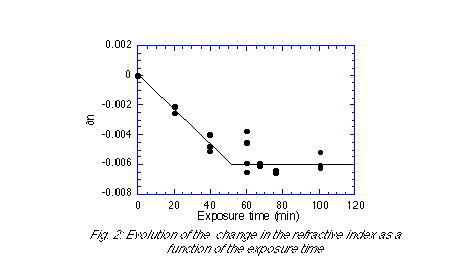
The samples used for this study were prepared using the Helicon Activated Reactive Evaporation HARE (plasma assisted reactive evaporation device that combines an evaporation source (electron-beam evaporator) and a high density Helicon plasma source, in a configuration in which the evaporant material is transported through the plasma source). The main advantage of the HARE over other plasma assisted deposition techniques is that the deposition of silicon dioxide is achieved by combining silicon and oxygen without other contaminants, such as hydrogen which occurs when silane is used as a precursor. Thus we expect our films to be hydrogen-free.
The deposition of the germanium doped silicon dioxide is performed by evaporating a melt of silicon containing 15% of germanium in an oxygen plasma. All depositions are carried out on silicon substrates (orientation <100>, p type). The substrates are not intentionally heated, and are left at floating potential (no bias). The limitation of this technique is the limited control over the stoichiometry of the deposited film due to the difference in evaporation rates between the silicon and the germanium. The evaporation rates can also vary in time as the temperature and the concentration of the melt change. The concentration of germanium in the deposited film has been measured by RBS, and was found to vary linearly from about 3% at the start of the deposition to about 25 % at the end.
The thickness of the deposited film is about 1.5 micron. This optical structure, air-film-silicon, can support 5 nominally bound modes, so that the refractive index of the film can be measured accurately using the prism coupler technique at 632.8 nm. The film was UV-exposed using an Excimer laser with average fluence of 1.74 J/cm2 at a wavelength of 193 nm. The GeO2 / SiO2 sample was exposed in 6 places for different periods of time.

Fig. 1 shows the refractive index of the film measured along part of the wafer. Points have been measured in a path across part of the wafer such that the path crosses two of the areas that were exposed. The values of the refractive index plotted are calculated from the values of the effective indices of the 5 modes coupled into the film measured by the prism coupler, and assuming a step index profile. Although the profile of our film is not uniform, due to the gradient in concentration of germanium, the standard deviation of the calculated refractive index of the film, using the 5 modes, is of the order of 0.01 % for the unexposed part and 0.002 % for the exposed part. Thus we believe that the perturbation due to the nonuniformity is negligible, and the calculated value is a good approximation of the mean refractive index of the film. The difference between the mean refractive indices in the exposed and unexposed areas is apparent, with a difference for the 58 min exposure (6.1 kJ/cm2 fluence) of - 0.005. As the sample was exposed to the full area of the beam, the non-uniformity of the beam is apparent in the profile of the refractive index change.
The concentration of germanium in the deposited film can be estimated from the measured value of the refractive index. The measured value of n is 1.492, from which we deduce that a is about 15%. This is confirmed by the RBS measurement, which gives an average concentration of germanium in the film of about 15%.

As the exposure time is increased, the decrease in refractive index becomes larger and appears to reach saturation; a change as large as -0.006 is observed. In order to confirm these results, we have deposited a pure SiO2 film using HARE, by evaporating pure silicon in an oxygen plasma We found that after UV exposure for 100 min, the change in index was only - 0.001, showing that the photosensitivity is due to the presence of the germanium in the film.
To confirm the absence of hydrogen in the deposited films, an SiO2 film was measured ex-situ using FTIR, and was found to have a spectrum which is close
to that of the thermal oxide. In comparison with films deposited by PECVD from a
mixture of silane and oxygen, the FTIR spectrum of the film deposited in HARE
does not exhibit any of the absorption peaks related to hydrogen incorporation.
A negative change of refractive index following UV exposure of PECVD germano-silicate has already been reported [10]. In that case, films were prepared from hydrogen-containing precursors, and the photosensitivity is attributed partly to the OH content of the film. In our case, a similar effect is observed although no hydrogen is present in the film.